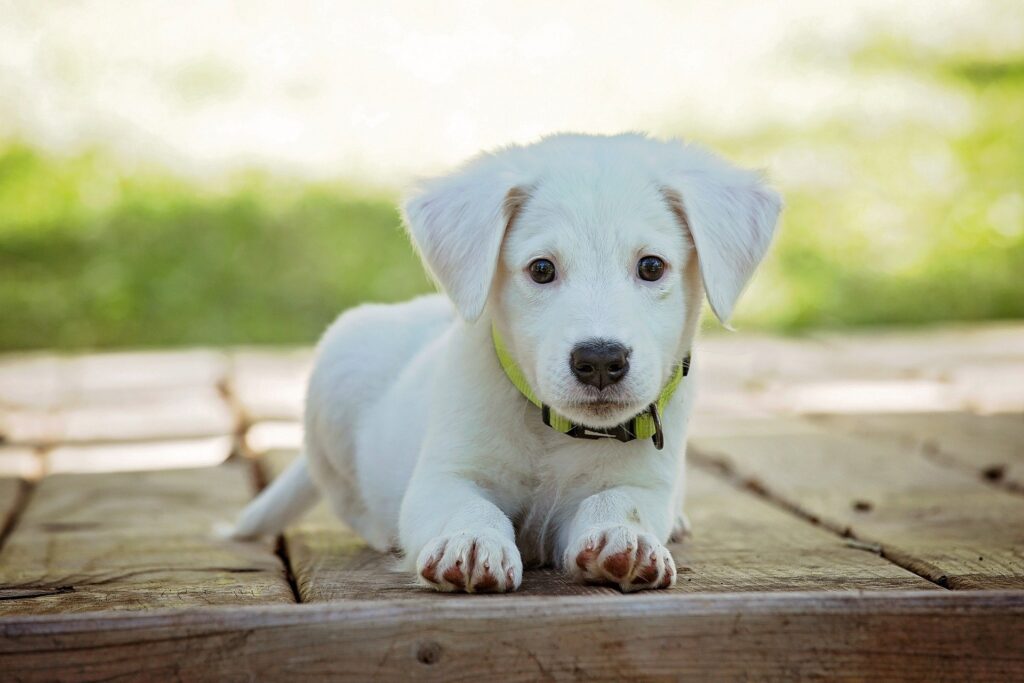Anyone that has ever tried to crate train a puppy has been there.
The crying, the sleepless nights. We get it!
Help! My puppy is keeping me up all night!
Over the years we have come to realize that each pup has its own style.
Some whine, some howl, some bark, some just scream at the top of their lungs.
Heck, we even had one puppy that we nicknamed “Baby Dolphin”. (Don’t ask!)
Of course, the morning after, your puppy is seemingly unfazed by their nighttime shenanigans.
You on the other hand, can barely get your coffee into your mug fast enough.

What does it mean to crate train a puppy?
What do people really mean when they talk about crate training a puppy?
Crate training a puppy basically refers to the process of gradually introducing your puppy to a crate, until the puppy is accepting of being confined there for periods of time.
Crate training is often the best approach for keeping your puppy safe when you can’t supervise them directly.
Biggest mistakes people make when trying to crate train a puppy
The most common mistake people make when introducing their puppy to a crate, is moving the training along too quickly.
If possible, start your puppy’s training with short, 10 minute sessions.
It’s best to plan these sessions for a time of day when your puppy will be tired.
Steps to crate train a puppy
- Begin by taking your puppy out to potty before you start the crate training session.
- Place your puppy crate in a quiet area of your home, away form household activity.
- Lure your puppy into their crate with a treat. This will help your puppy build a positive association with the crate.
- Make sure your puppy is comfortable and entertained while in their crate. Give your puppy something soft to lay on, and a stuffed puppy kong to keep them busy. (NOTE: Always supervise your puppy when they have access to toys or chews inside their crate)
- Keep your puppy in their crate for 10 minutes. Your puppy will probably not like their crate at first, unless you are very lucky. Be consistent and don’t give in to the puppy whining or howling.
- After ten minutes are up, release the puppy from the crate. Try to wait until your puppy stops crying before you let them out. You may have to be quick here. At first you may only have a 1 to 2 second interval without the puppy crying. I’m not going to lie, it will be hard to hear that sweet puppy crying, but make sure you complete the session. If you let the puppy out when it cries, it will learn to continue that behavior.
Related post: “Puppy toys for teething”

Crate training a puppy troubleshooting
So you’ve started crate training your puppy.
You followed all the steps but your puppy is still not accepting their crate.
Here are a few things to try.
- Place an old towel over the puppy crate. Be sure your puppy has adequate air flow into their crate, and that they can’t pull the towel into their crate. This will normally help your puppy settle down and rest. This creates a den like atmosphere for your puppy.
- Try leaving on a T.V, radio, or fan for background noise. This is also called white noise.
- Try bringing your puppy’s crate into your bedroom at night. Sometimes a puppy will be comforted to hear their humans.

Final Thoughts
The goal with the short training sessions is simple.
They communicate to your puppy that his crate is safe, comfortable, and a pretty awesome place to be.
One of the best tips I can give you, is to only crate your puppy when it’s absolutely necessary. (Outside of the training sessions and at night)
The majority of the puppies that grow to hate their crate, have been forced to spend far too much time in them.
Once this happens, the puppy stops seeing its crate as a happy place, and instead begins to see it as a prison.
As your puppy becomes more comfortable in their crate, you can gradually extend the time from 10 to 20 minutes.
Then slowly work up to the amount of time the puppy needs crated for.
**Remember, these strategies are not magic.
It will take time to fully crate train your puppy, but through consistent effort, you will be successful.
Be sure to have realistic expectations and above all, be patient with your puppy.
We wish you the best on your new puppy adventure.
Related Post: “How to housebreak a puppy“
This post contains affiliate links, which means we make a small commission at no extra cost to you. See our full disclosure Privacy Policy.
Contents



